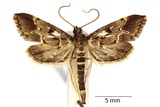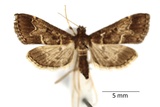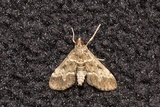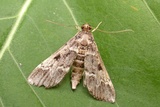Duponchelia fovealis Zeller, 1847 Species
Last modified: Dec. 24, 2023, 3:01 p.m.
A species imported with greenhouse crops which escaped to nature and which is able to survive when winters are not too cold.
Details
- Classification
- Family: Crambidae > Subfamily: Spilomelinae > Tribus: Steniini > Genus: Duponchelia > Species: Duponchelia fovealis
- Vernacular names
- Duponcheliamot (NL)
- First mention in Belgium
- Faquaet M. 2000. Duponchelia fovealis, een nieuwe soort voor de Belgische fauna (Lepidoptera: Pyralidae). — Phegea 28(1): 13–14. On page 13. view page
- Status
-
Naturalised In Belgium since August 1999.
Native to the tropics and in the northern Mediterranean area. Probably imported into Belgium with greenhouse crops into greenhouses where it became a serious pest. Escaped moths can survive mild winters and hence build up populations in nature. From ca. 2004 onwards, the species is observed every year in several Belgian provinces and it is becoming more common.
Distribution
Bionomics
The caterpillar constructs a silken tube from which it feeds on the leaves, creating holes in the leaves. It has also been observed to feed on the flowers and sometimes it even bores into the stem of various cultivated plants. Pupation in a web with a mixture of frass and soil particles.
The adults are mainly active at night and come to light.
Flight periods
The species flies in more generations a year and can be observed all year rond.
Observed on
- Substrates:
- Polyphagous
Extremely polyphagous, living on all kinds of greenhouse crops and ornamental plants, also on aquatic plants.
Habitat
Native to freshwater and saltwater marshlands.





